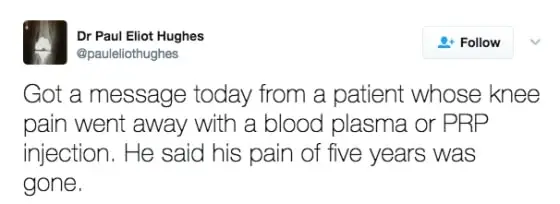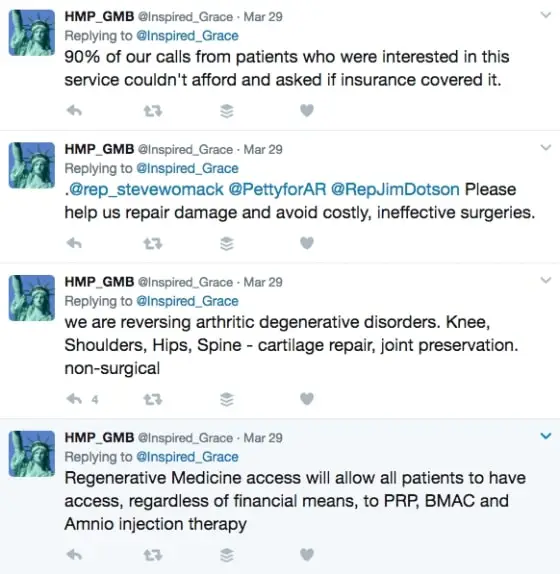| Item | Price | Qty | Total | |
|---|---|---|---|---|
 Loading Cart...
Loading Cart...Why Insurance Will Soon Start Paying For PRP Injection

As a nation, we’re already seeing big movements in the adoption of Regenerative Medicine. Last November’s 21st Century Cures Act and the recent Arkansas HB2014 bill are just two examples. We believe it’s a matter of time before mainstream insurance companies will not only approve PRP Injection (at least for selected cases) but insist on it as an alternative to Corticosteroid injections and Hyaluronic Acid injections.
Athletes who have PRP injections instead of the standard anti-inflammatory drugs is a regular feature in Sports news these days. The Met’s Steven Matz had a platelet-rich plasma injection on last Wednesday. Last month it was David Wright.

We covered the case against Hyaluronic injections here.
And recently there has been larger scale studies in China. First it was from Shanghai Jiaotong University School of Medicine earlier in January. It included 14 Randomized Controlled Trials comprising 1423 participants and has shown that PRP Injection is more effective in the treatment of knee OA in terms of pain relief and functional improvement compared with saline placebo, HA, Ozone, and Corticosteroids. This is a randomized controlled trial with level 2 evidence. Full study here.
More recently it was a study at Chongqing Medical University, China that included 10 randomized controlled trials with a total of 1069 patients which found out that compared to HA and saline, PRP injection is more effective for pain relief and functional improvement in patients with symptomatic knee OA. You can read the full brief here.
And now, we also have a new randomized, double-blinded clinical trial confirm that Platelet-Rich Plasma injections can perform as well as Corticosteroid injections.
Back here in the US, researchers have been busy too. They did this double-blind Randomized Controlled Study on Lumbar Intradiskal PRP Injections for Low back pain (LBP). And as expected, PRP group showed significant improvements in FRI, NRS Best Pain, and NASS patient satisfaction scores over 8 weeks compared with controls.

A Significant Win for PRP Injection
Every year, tens of millions of injections are given for OA knees. Out of these, only a tiny fraction are PRP Injections. The majority injections are corticosteroid or HA injections. Which only accelerates the knee degeneration. Which means most of these patients go on to have the expensive and traumatic knee surgery leading to over 1 million the knee-replacement surgeries performed annually worldwide.
The question now is…
Why are we continuing to use the expensive, side-effects-ridden Corticosteroid or HA injections for Arthritis symptoms? It’s important to note that one of the side-effects of Corticosteroid injections is Osteoporosis. That’s why many physicians insist on a bone density test before these steroid injections.

The bottom line is that the steroid injections which were introduced in 1948 as a standard treatment for spine and sports injuries should be replaced by PRP Injections.
Or else we’ll continue having 3.5 million knee replacements costing insurance – at $25K per pop, an astounding $87.5 billion – a sum that ordinary, healthy citizens help pay.
The Problem: 90% Of Patients Call, Only 10% Take It
This statistic will hit you in the head right away the moment you start looking at the Platelet-Rich Plasma industry. I mean, the science of Platelet-Rich Plasma is simple. So everyone understands the risks (or the lack thereof). And almost all patients with wanted an extra hand in healing of tendons, ligaments, muscles & joints would love to try PRP injections.
But they don’t want to pay for it. Understandably. Because they are paying dearly every month for their insurance and why should they paying this PRP injections? It’s not patient’s fault. They shouldn’t be paying for it when they are paying for and expecting world-class medical coverage.

PRP market has climbed to an estimated $120 million in 2016. If people can vote for this treatment with $120 million of their own money, without any single red cent from the big pharma, there’s definitely something the 90% of the interested-but-refuse-to-pay patients miss out on.

We Need To Work On Standardization of PRP Injections
One thing researchers agree is that we need standardization. For instance, doctors now are unsure of the duration PRP Injection’s benefits last. If we have a prolonged condition like arthritis, should injections be given at a monthly interval or twice a month? Or should the injection be repeated at all? Because there are several studies that trace PRP Injection’s effects up to a period of 24 months.
All we need is studies that confirm the best practices that the PRP market is already following in terms of
- Concentration of the platelets and RBC in the preparation.
- Frequency of intra articular injections needed.
- Security measures to prevent overuse of this novel procedure.
Then it’ll be easy for insurance companies to trust PRP Injections as a valid procedure to not only help heal their members without any side-effects or complications but also help them avoid expensive surgery. Now, that’s what’s called a win-win-win.
You see the big winner probably will be the insurance.
So it makes sense for insurance companies to take the lead in implementing the standardization procedures since the big pharma is not interested as they stand to gain nothing.
Is that what will happen? Let’s wait and see.


